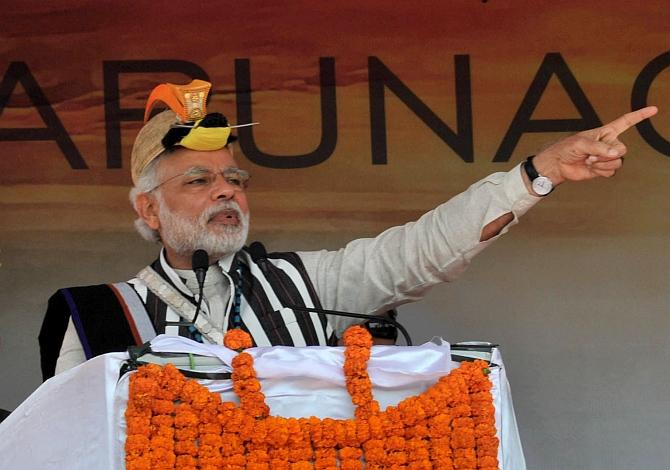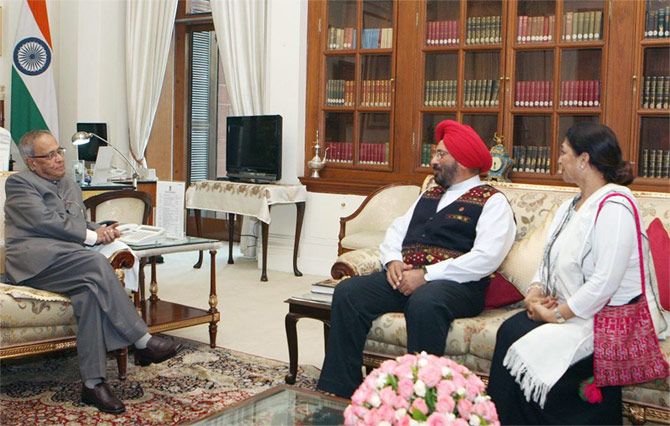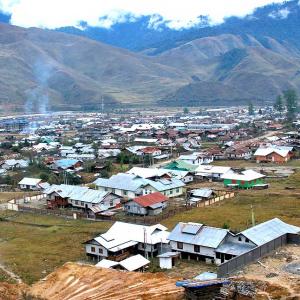
Though the Chinese find it necessary to oppose the visits of Indian leaders to Arunachal Pradesh, they want to keep the objections at a moderate level lest it cast a shadow on Narendra Modi's visit to China in May, says D S Rajan.
The main purpose of China's latest protest to India on Prime Minister Narendra Modi's visit to Arunachal Pradesh is to reinforce its border claim, especially at a time when preparations are afoot for the Indian leader's first official visit to China in May and a proposal for a new code of conduct on border management is under discussion between the two sides.
A specific reason could be China's desire to influence the next 18th round of talks between the special representatives of the two sides, due to take place soon. Notably, the Chinese lost no time in reacting to the visit.
A comparison of the available texts (both in English and Chinese) of the latest protests against the visit in China with those relating to protests made in 2009 (Dr Manmohan Singh's visit to Arunachal Pradesh), 2012 (The then Indian defence minister's visit to the state) and 2013 (President Pranab Mukherjee's visit), indicates that though the Chinese find it necessary to oppose India for 'arranging' visits of Indian leaders to a disputed area, they want to keep the level of objections at a moderate level at this crucial juncture, without giving any sign of overstepping, lest that cast a shadow on the outcome of the planned big event in May.
Image: Prime Minister Narendra Modi in Arunachal Pradesh, February 20, 2015.
On February 20, unlike in the past, China used a combination of its three top channels to criticise India for Modi's visit to what it called 'disputed' border region -- China's Vice Foreign Minister Liu Zhenmin, spokesperson of the Chinese foreign ministry and the Chinese embassy in New Delhi.
Liu summoned India's ambassador in Beijing to convey his country's 'stern representation' to India; he expressed on the occasion his country's 'strong dissatisfaction' over and 'staunch opposition' to the visit.
The foreign ministry statement used the terminologies of 'strong concerns' over and 'diametrical opposition' to the visit. Both asked India not to 'complicate' the border situation.
The Chinese mission in Delhi on its part lodged its 'representation' to India. In 2009, the word 'strong dissatisfaction' was used in the protest made by the Chinese foreign ministry, with addition that China was 'deeply upset' and had 'grave concern' over the visit.
In both 2009 and 2012, the Chinese foreign ministry statements asked India, 'not to trigger disturbance' in the disputed border area; the word 'disturbance' was not found in 2013 and also now in 2015, Instead, the word 'not complicate' is used on both occasions.
The Chinese protests in 2009, 2012, 2013 and 2015, almost have identical contents. As instance, they all mention China's non-recognition of the McMahon Line and the three areas 'belonging' to it.
 They do not name any Indian leader for their visits. Also, all the protests make no reference to the western sector. In this regard, Liu's mention that there are 'significant' disputes in the eastern section could be important.
They do not name any Indian leader for their visits. Also, all the protests make no reference to the western sector. In this regard, Liu's mention that there are 'significant' disputes in the eastern section could be important.
Image: Then prime minister Dr Manmohan Singh being received by then Arunachal Pradesh governor General J J Singh (retd) and then Arunachal Pradesh chief minister Dorjee Khandu in Itanagar, Arunachal Pradesh, on January 31, 2008. Photograph: A Maitra/Press Information Bureau.
China may not be bother about the western sector areas as they are already under its occupation. Also, there was no reference to the term 'Southern Tibet' in any of the protests. Is China avoiding the use of this term in bilateral formal contacts? There is also no claim in the protests that the entire Arunachal Pradesh is part of China.
One Chinese ambassador in New Delhi had made such claims years ago. However, the sovereignty claim seems to be present by implication in Liu's remarks to the Indian envoy that the Indian prime minister's visit has 'undermined' China's territorial sovereignty.
In any case, China has already claimed sovereignty over Arunachal Pradesh through its maps. Recent examples include the publication in China of a new official map in June 2014, while India's vice-president was still on Chinese soil, which showed Arunachal Pradesh as Chinese territory.
In the latest protest, the Chinese foreign ministry's demand is for a 'fair and reasonable' resolution of the border issue through negotiations without mentioning the need for a 'mutually acceptable solution.'
On the other hand, the China-India joint statement issued after President Xi Jinping's visit to India in September 2014 contained reiteration of the commitment of the two sides to a 'fair, reasonable, mutually acceptable solution' to the boundary issue.
It has been seen that China sometimes uses the words 'mutual accommodation' or 'mutually acceptable solution' and sometimes does not. The reasons for this are not clear.
Though there appears to be no direct connection, China's latest protest may require to be seen in the context of the Japanese recognition of Arunachal Pradesh as part of India (Japanese Foreign Minister Fumio Kishida in New Delhi in January). For the first time, Japan appears to have sided with India on the Arunachal issue. Also, for the first time in recent years, a foreign power seems to have come in support of India on the issue.
With apparent concern over likely signals on the internationalisation of the Arunachal issue, the Chinese foreign ministry promptly conveyed its 'serious concern' to Japan on this count.
A Chinese scholar affirmed that Kishida's words had 'unveiled Japan's intent of uniting the countries that have territorial disputes with China, in an attempt to create a strong impression that Japan, along with China's other neighboring countries, is bullied by a rising China.'
Why is China consistent in objecting to visits of Indian leaders to Arunachal Pradesh, while at the same time seeking friendship with India?
 This has to be understood from the point of view of China's current core interest-based foreign policy course. Under it, China would like to promote win-win cooperation with the outside world, but would not compromise its 'core interests' -- on all matters concerning the country's territorial sovereignty.
This has to be understood from the point of view of China's current core interest-based foreign policy course. Under it, China would like to promote win-win cooperation with the outside world, but would not compromise its 'core interests' -- on all matters concerning the country's territorial sovereignty.
Image: President Pranab Mukherjee with then Arunachal Pradesh governor General J J Singh (retd) and his wife Anupama Singh.
China says that friendship and the 'no compromise' position are the two 'pillars' of its diplomatic strategy. India should therefore expect China's adoption of a bilateral approach towards it, which simultaneously mixes elements of both cooperation and assertion. Some analysts say that the influence of the People's Liberation Army over foreign policy issues, may be contributing to China's assertiveness abroad.
But it has to be acknowledged that the whole party and government including the military in China function under a unified command which decides the foreign policy of the country; any idea of isolating the PLA in the process could be wrong.
Another reason behind China's protests could be the presence of the Dalai Lama and the Tibetan government in exile in India.
Replying to a question on the Tibetan government-in-exile's stand on the Chinese claim over Arunachal Pradesh, Dr Lobsang Sangay, prime minister of the Tibetan government-in-exile, said it recognises the McMahon Line, according to which Arunachal Pradesh is a part of India.
'The Tibetan government-in-exile is bound by the Simla Agreement signed with the British in 1914, which accepts the McMahon Line as the international border and there is no reason to deviate from the agreement,' Dr Sangay asserted.
Beijing seems to be wary of any attempt to link the Tibet issue with the Sino-Indian border; it considers the former as an internal problem. For the outside world, the linkage is obvious.
On the matter of Arunachal Pradesh, all protests against India coming from China contain a stand that China does not recognise the McMahon Line. They argue that China did not sign the 1914 Simla Agreement. Revealing India's firm and unambiguous position, Modi, during his recent visit, said, 'Arunachal Pradesh is an integral part of India and will always remain so. No power on earth can snatch away Arunachal Pradesh. Times have changed. The world does not welcome the mindset of expansion in today's times. China will also have to leave behind its mindset of expansion.'
India's interests may lie in effectively countering the Chinese stand as reflected in their protests.
Firstly, India may remind China the fact that all attending parties in the 1914 Simla convention -- British Indian Foreign Secretary Henry McMahon, Lonchan Shatra representing Tibet and the Chinese delegate Ivan Chen -- recognised Tibet's sovereign authority to negotiate its boundary with India as well as the mainland. As such, the Tibet-India boundary fixed at Simla on the basis of the McMahon Line is legal.
Secondly, India can tell China to take cognisance of the map submitted by the Chinese representative at the Simla conference, which clearly showed Tawang as part of India.
Thirdly, China can be informed by India that the Chinese representative to the convention put his initials in the draft of the Simla Agreement, though he refused to sign the final agreement.
Fourthly, a question can be put to China as to why it follows a self-contradictory approach by considering the trade agreement signed in Simla as valid, but not the border agreement.
Fifthly, India can ask China to recall that then premier Zhou Enlai in his letter to then prime minister Jawaharlal Nehru made it clear that he accepted the McMahon Line between China and India in the interest of bilateral friendship though he did not like the name 'McMahon' Line (Nehru's letter to his Burmese counterpart U Nu, April 22, 1957).
Lastly, India can inform China that even before the McMahon Line was formerly delineated, there was no Chinese presence in the then North-East Frontier Agency.
D S Rajan is Distinguished Fellow, Chennai Centre for China Studies.










